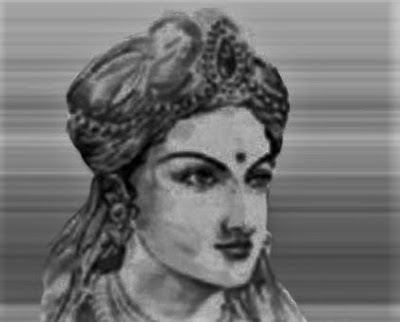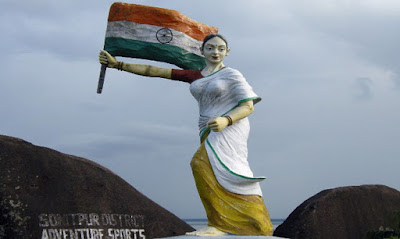“When woman, whom we call abala becomes sabala, all
those who are helpless will become powerful.” - Mahatma Gandhi;
at the All India Women's Conference in Dec 1936.
A large group of people, belonging to
different regions and different timelines, gave their all life to regain India’s
independence from the colonial regime of the British invaders. Amongst these
patriots, millions were women, some known and others uncelebrated, about whom
most of us never heard before. They fought equally hard but never got any share
of the limelight. Their only focus was seeing
an independent India. As citizens of this country, we should know about
them. Because, they deserve every Indian’s acknowledgement, ovation and
respect. Here’s taking a look at some of those unknown women who inspired
India’s freedom struggle.
Velu Nachiar
Rani Velu Nachiyar (1730-1796),
was a queen of Sivaganga estate in 1760-1790. She became the first
revolutionary who opposed the rule of British in Tamil Nadu even before the
Sepoy mutiny which is considered as the first war against the British rule
in India. In collaboration with Hyder Ali and Gopala Nayaker, she waged a war
against the British and emerged victorious. Eventually she went on to produce
the first human bomb as well as establish the first army of trained women
soldiers in the late 1700s.
She is celebrated by Tamilians as Veeramangai (brave women).
Abadi Bano Begum
Abadi Bano Begum was born in 1852 in Rampur (U.P.).
Abadi Bano Begum, popularly known as Bi Amma was
an ardent nationalist whose family members had suffered the trauma of 1857
revolt and she had a strong desire to see the country free from British rule.
Abadi Bano came from a simple conservative Muslim family of Lucknow who had rarely
stepped out of the house on her own. She was mother of Maulana Mohammad Ali
Jauhar, who was the leader of the Khilafat Movement and co-founder of the Jamia
Milia Islamia University. He joined the freedom movement and was arrested for
his activities. The year was 1917, Abadi Bano took the brave decision to
address a political gathering to speak out in support of her son. She addressed
the crowd from behind her burqa but her message was strong and firmly in
support of the freedom struggle. This was perhaps the first instance of a
Muslim woman addressing a public gathering.
Begum Hazrat Mahal
Begum Hazrat Mahal also known as Begum of Awadh,
was born on 1820 at Faizabad, Awadh. She was the first wife of the then
Lucknow ruler Nawab Wajid Ali Shah.
Begum Hazrat Mahal rebelled
against the British East India Company during the Indian Rebellion of
1857. She was also a big supporter of fellow mutineers like Nana Saheb.
Begum Hazrat Mahal, famously known as the 'Lakshmi
Bai' of Awadh, took charge of Awadh during the rebellion, after her husband was
exiled to Calcutta. She fought boldly and
also urged the rustic folks to take part in the war. Later her armed forces
seized control of Lucknow and she placed her 14-year-old son on the throne of
Awadh on July 5, 1857. She greatly motivated the common peoples to rebel against the
British Raj. Such was her devotion and pledge to her people that the Begum
even went on to brace the city of Lucknow against the advancing British troops.
After a long siege, Lucknow was again re-captured by the British, forcing
Hazrat Mahal to retreat in 1858 to Nepal.
She spent the remaining years of her life in
Nepal, passing away in 1879 in Kathmandu.
Bhikaji Cama
Bhikaji Cama was born on September 24 1861 into a
large, wealthy Parsi family. Influenced by an environment in which the Indian
nationalist movement was taking root, Bhikaji was drawn toward political
issues from a very early age. At the age of 23, she was married to Rustom Cama,
who was son of K. R. Cama.
Madam Cama had set up ‘Free India Society’ in
London in order to rally Indian youths. She also went to Paris and started a center there.
She was the one who planned the Indian national flag. She waved the
flag in the International Socialist Congress held at Stuttgart in Germany,
1907, as an Indian representative. She appealed to the delegates to co-operate
with the Indians so that they all can free themselves from the British
rule.
As an active social worker and philanthropist, she
gave away all her assets to help out an orphanage for young girls. A number of
Indian cities have streets and places named after Bhikhaiji Cama, or Madame
Cama. On India's 11th Republic Day, 26 January 1962, the Indian Posts and
Telegraphs Department issued a commemorative stamp in her honor.
Matangini Hazra
Matangini was born in the
small village of Hogla, near Tamluk in 1869. She was married and was widowed by
the age of eighteen. Thereafter she devoted herself to social service, working
tirelessly for others.
In 1905, when the
Nationalist movement was at its peak in Bengal, Matangini Hazra became deeply
inspired and influenced by Mahatma Gandhi, and followed his teachings so
religiously that she later came to be known as 'Gandhi Buri' (old lady Gandhi).
She also played a great role in Non-Cooperation Movement.
This unsung heroine was
shot dead by the British during a procession, when they realized she was too
feisty and would be able to sprout more nationalism among fellow Indian. Despite
being shot thrice, she never backed down, and marched forward with the national
flag, repeating the slogan, “Vande Mataram!”
Bhogeswari Phukanani
Bhogeshwari, a house-wife, actively participated in the freedom struggle and instructed her six sons and two daughters to do the same. The valorous fighter was brutally shot down by the British for launching the revolutionary mass program, the 'Bharbhuj'.
Raj Kumari Gupta
Raj Kumari Gupta was
born on the February 2, 1889 in Lucknow to princely family of Kapurthala, a
part of undivided India.
Raj Kumari Gupta was one of the leading lights in
India’s fight for independence. Very few
people are aware of her contribution to the famous Kakori conspiracy. Raj
Kumari and her husband worked with Mahatma Gandhi and Chandrashekhar Azad and
she played a crucial role in the Kakori case as well. She was in charge of
supplying revolvers to those involved in the operation. While hiding firearms in her undergarments, she
was arrested with her three-year-old son. Ironically though, her in-laws
disowned her.
She
was the first Indian woman to hold the position of Cabinet Minister.
Kamaladevi Chattopadhyay
Kamaladevi was born on 3 April 1903 into a
Saraswat Brahmin family in Mangalore. She was initiated into politics at an
early age.
We may be known Kamaladevi
as a distinguished theatre actor, but, very few are aware of the important role
she played in India’s fight for independence.
She was the first woman to run for a legislative seat in India and also
the first Indian woman to be arrested by the British regime for her active role
as a patriotic leader. She played a very vital role as a social reformer and
brought back handicrafts, theatres and handlooms to help in uplifting the
socio-economic standard of the Indian women.
Lakshmi Sahgal
Lakshmi Sehgal was born
Lakshmi Swaminadhan on October 24, 1914 in Madras. She was one of the brave
hearts who served a sentence in a Burma prison for her role in the World
War II. When she heard that Netaji Subhas Chandra Bose was recruiting women
soldiers as well, she returned to her motherland to enroll herself into the
army. As ordered by Netaji, she established and lead the Rani of Jhansi
Regiment, comprising of women soldier in Azad Hind government.
An officer of the Indian
National Army, she was a pioneer personality of the Indian Freedom Movement and
aided numerous wounded people during her time of service.
Tara Rani Srivastava
Tara Rani Srivastava was born into a very poor
family in Saran, Bihar. She was married at a very young age of 13. She
along with her husband Phulendu Babu actively participated in the Quit India
movement.
It was the day, when Mahatma Gandhi called the
people for hoisting the flag in front of Siwan police station. On Gandhiji's
call, Phulendu gathered a massive crowd of men and women in front of the
police station to hoist the national flag on its roof. Both Tara and
Phulendu stood in front of the crowd. Soon police started firing and Phulendu
fell to police bullets. But Tara Rani was not dispirited, she bandaged her
husband's wounds and marched with the national flag straight towards the
police station. By the time she returned, her husband had died. She without losing
her courage continued her struggle despite of facing all hurdles on her
way.
Sucheta Kriplani
Sucheta Kriplani was born in Ambala, Punjab to a Bengali Brahmo
family on 25 June 1908.
She was a Gandhian and worked with him during the
partition riots as well as the independence movement. She also was a
formidable member of the Indian national Congress and was the founder of the
All India Mahila Congress in 1940. On 15th August, 1947, she sang Vande
Mataram in
the Constituent Assembly. Sucheta Kriplani was
the first woman to become the Chief Minister of an Indian state (UP).
Durga Bai Deshmukh
Durgabai Deshmukh was born on 15
July 1909. She was an Indian freedom fighter, lawyer, social worker and
politician. She played a prominent role in Indian freedom movement. She led
many Satyagraha movements and as a volunteer for the Indian National Congress,
worked closely with Mahatma Gandhi. She was a member of the Constituent
Assembly of India and the Planning Commission of India.
Aruna Asaf Ali
Aruna Asaf Ali was born as Aruna Ganguly on 16
July 1909 in Kalka, Punjab, into a Bengali Brahmo family.
Aruna was an active social worker and freedom
fighter who, along with her husband Asaf Ali, was involved with the Indian
National Congress. She took part in the Salt Satyagraha movement as well as
other protest marches. She was imprisoned for her so-called impertinence. While
in prison, she continued her struggle, and also raised her voice against the
inhuman treatment of convicts. When she was 33 years old, she gained some
prominence as she hoisted the Indian National Congress flag during the Quit
India Movement at the Gowalia Tank Maidan in Bombay, 1942.
Parbati Giri
Parbati Giri, is better
known as the Mother Teresa of Western Odisha, was born in Samlaipadar village
near Bijepur of the undivided Sambalpur district on 19 January 1926.
Parbati Giri was a prominent brave heart from
Odisha who played a significant role in the Indian Freedom Struggle. She
became an integral member of the Quit India Movement initiated by Mahatma
Gandhi at the age of sixteen. Due to her anti-British government activities,
she was imprisoned for over two years. Even after her release, she continued
serving the nation by giving shelter to orphans of her village. She opened an
orphanage at Paikmal village and devoted rest of her life for the welfare
of orphans.
Kanaklata Barua
Kanaklata, also known as 'Birbala' was an Indian
freedom fighter, who was born in the Borangabari village of the undivided Darrang district of Assam on 22 December 1924.
This unsung heroine from Assam played quite a
crucial role in India’s struggle for freedom. During the Quit India
Movement Kanaklata joined the Mrityu Bahini, a death squad comprising
groups of youth from the Gohpur sub division of Assam. On one fateful day,
she accompanied other volunteers of the Movement to hoist the national flag,
but was prohibited by the police. Though she tried convincing that her
intentions were noble, the British police force shot her down, along with
several others. Thus, at the tender age of seventeen, this young woman
sacrificed her life for her country.
















No comments:
Post a Comment